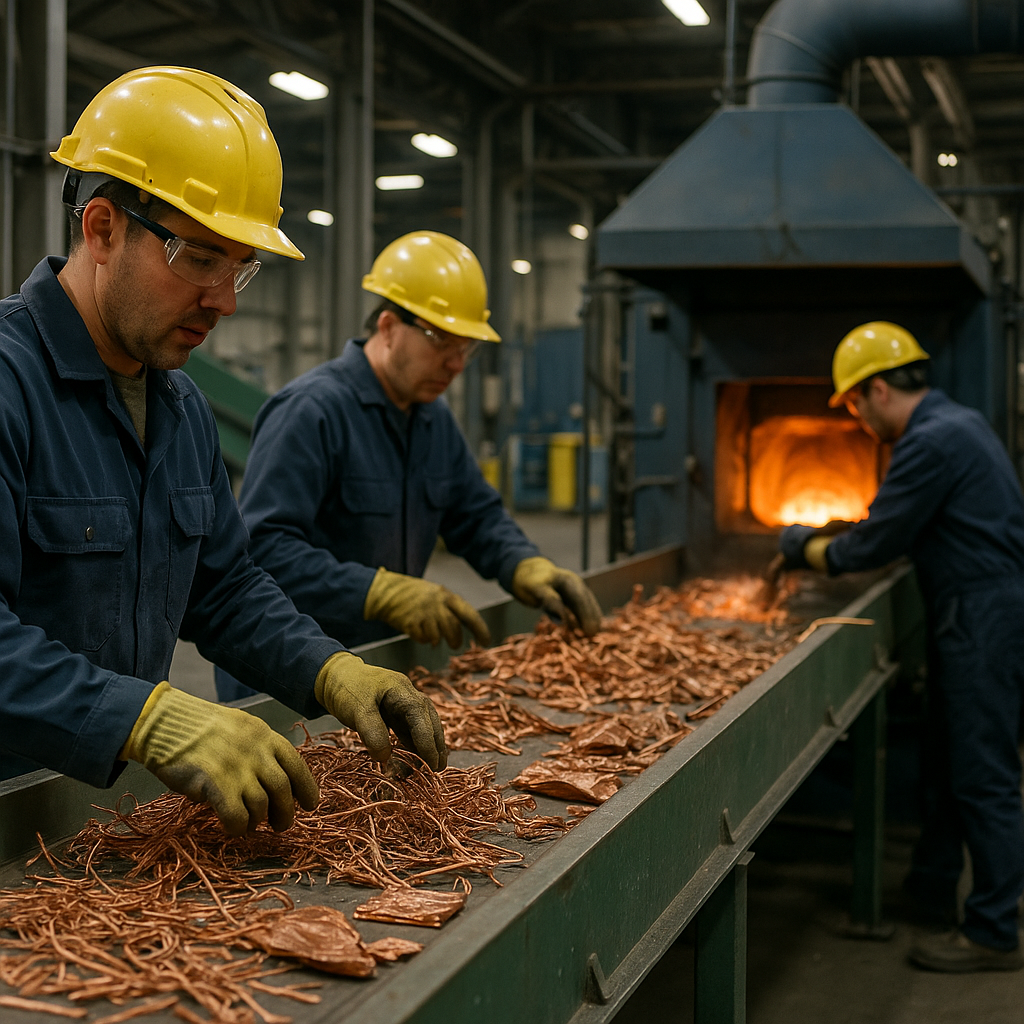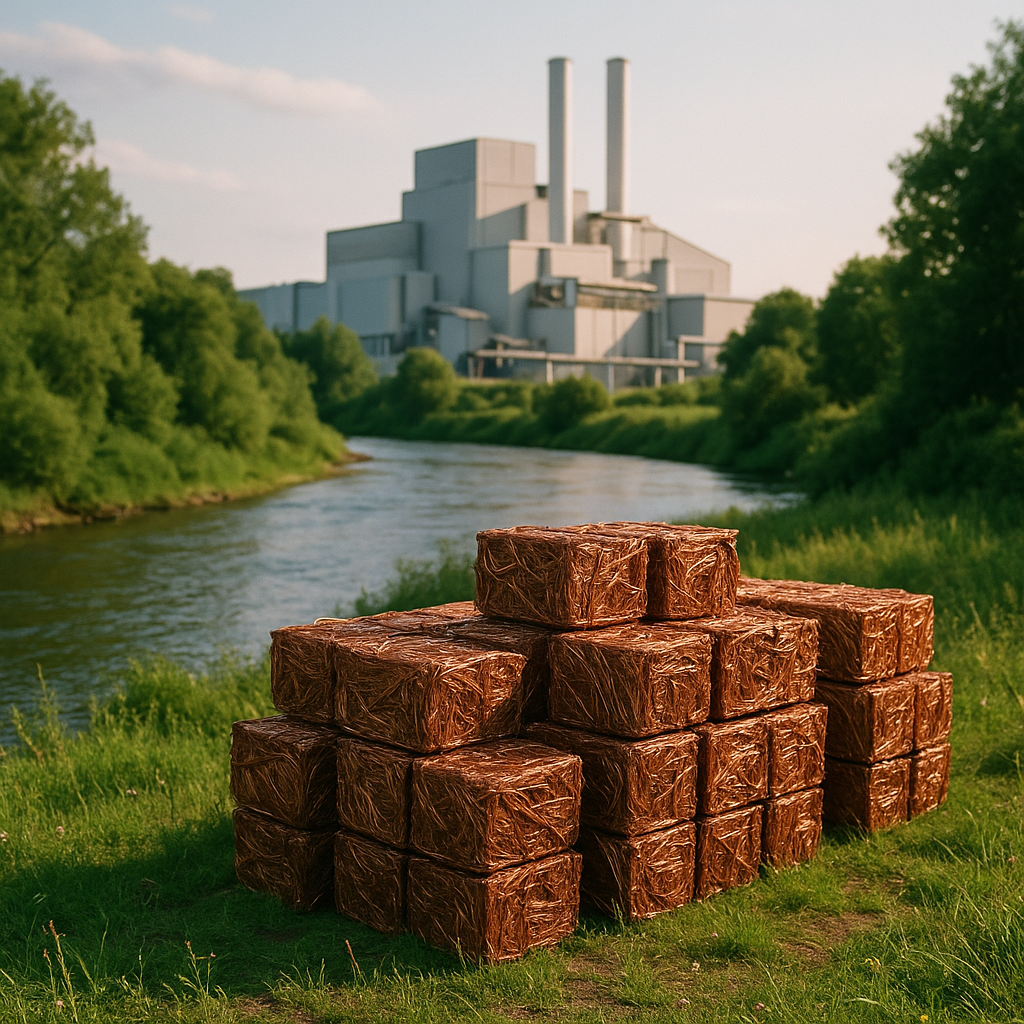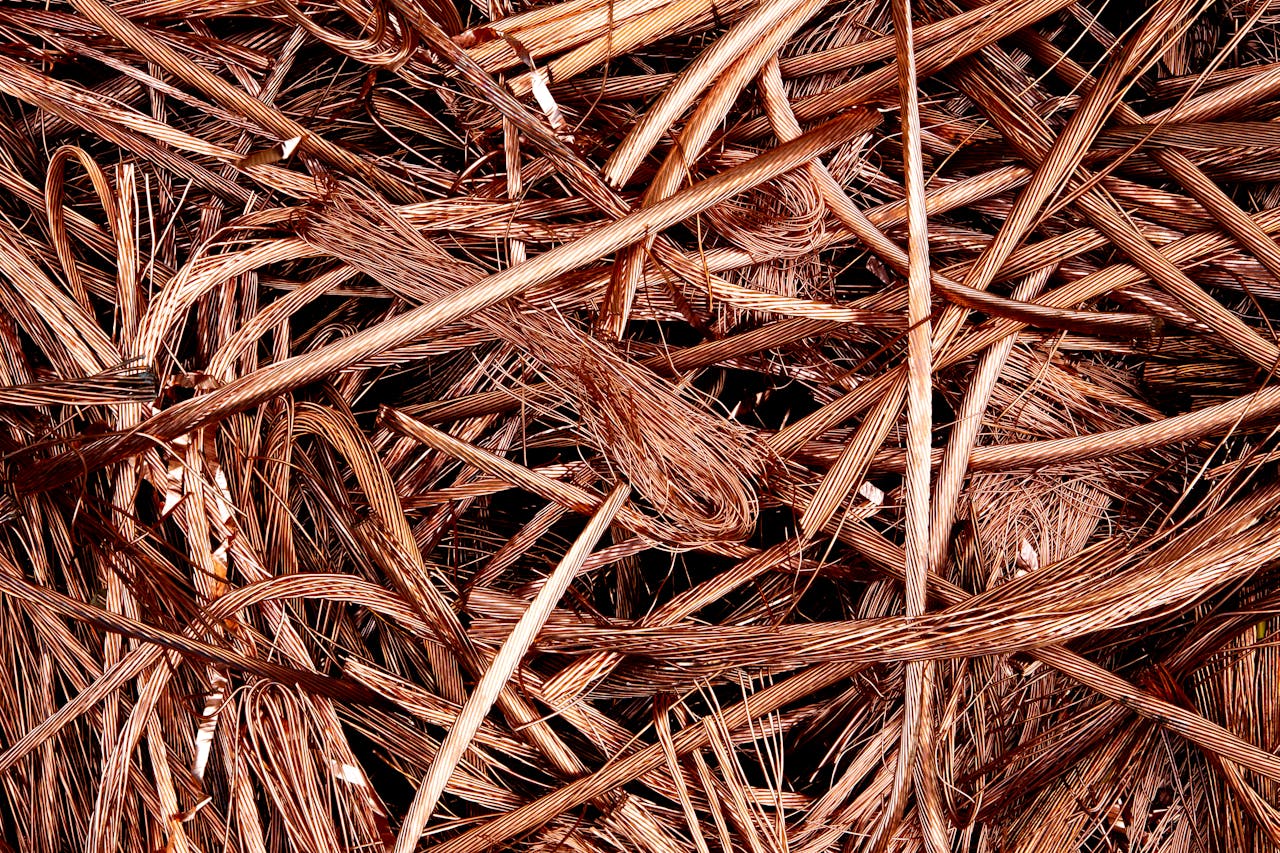5901 Botham Jean Blvd, Dallas, TX 75215
What Are Eco-Friendly Copper Recycling Methods?
June 22, 2025Recycling copper saves up to 85% of the energy required for primary production from raw ore. This efficiency makes copper recycling one of the most environmentally beneficial metal recovery processes available today. The energy savings translate directly to a significant reduction in carbon footprint, with each ton of recycled copper preventing approximately 1.5 to 2 pounds of CO₂ emissions compared to mining new material.
Eco-friendly copper recycling methods efficiently reintroduce this valuable metal back into the economy while minimizing environmental impact. These techniques have evolved to maximize material recovery while using substantially less energy than extracting copper from virgin ore. The process preserves natural resources that would otherwise be depleted through mining operations and requires far fewer resources to process.
Beyond direct benefits to copper conservation, these recycling methods drive the recovery of other precious metals. When complex scraps like electronic waste undergo recycling, valuable materials including gold, silver, and nickel are also recovered. This additional benefit makes copper recycling a cornerstone of sustainable metal management and a key component in building a more circular economy.
How Does the Copper Recycling Process Work?

The copper recycling process transforms discarded copper items into high-quality material through a series of specialized steps. This method ensures that recycled copper retains the same quality and properties as newly mined copper. Let’s examine each critical stage of this efficient process.
Collection and Sorting
The process begins with gathering copper-containing materials from various sources, including old buildings, electrical devices, plumbing fixtures, and electronic components. Workers then sort these materials based on copper content and quality.
Proper sorting is crucial for achieving high-quality recycled copper. Materials are categorized by type and purity level to ensure optimal processing, maximizing efficiency in later stages of the recycling process.
Preprocessing and Cleaning
Once sorted, the copper materials undergo preprocessing to remove non-copper components. This involves manual or mechanical separation of materials like plastic insulation from copper wires, aiming to isolate the copper as much as possible before further processing.
Cleaning follows to remove dirt, oil, or other contaminants, ensuring that only copper and minimal impurities enter the next stages. Clean copper materials lead to higher quality recycled products.
Shredding and Size Reduction
The cleaned copper materials are then fed into industrial shredders, which cut and tear the copper into smaller pieces. This increases the surface area, essential for efficient melting in later stages.
The shredded copper may undergo additional processes like granulation or grinding, further reducing the size of copper particles. Smaller pieces melt more uniformly and quickly during the melting phase.
Melting
The shredded copper enters specially designed furnaces where temperatures exceed 1,980°F (1,080°C). At these high temperatures, copper transforms from a solid to a liquid state. Modern furnaces use energy-efficient technologies to reduce environmental impact.
During melting, impurities float to the top as slag and are removed, taking advantage of copper’s unique properties. The molten copper begins to take on a purer form at this stage.
Purification
The molten copper undergoes purification to remove remaining impurities, which can involve chemical processes or electrolysis depending on the desired purity level. These methods separate copper from other metals and elements.
The purification process can achieve copper with 99.9% purity or higher. High-purity copper is essential for applications in electronics and electrical systems.
Casting and Fabrication
The purified molten copper is cast into various forms such as ingots, bars, or sheets. These standardized forms serve as raw materials for manufacturing new copper products, following strict quality control measures.
After cooling and solidification, the recycled copper is ready for fabrication into new products, such as electrical wiring, plumbing pipes, electronic components, or architectural elements. The recycled copper performs identically to virgin copper in all applications.
Notably, this entire process uses up to 85% less energy than mining new copper. It also produces fewer carbon emissions and less air pollution. The recycled copper maintains all the valuable properties that make copper desirable in numerous industries.
What Are the Environmental Benefits of Copper Recycling?
Energy Savings and CO2 Emissions Reduction
Recycling copper uses up to 85% less energy compared to mining and refining new copper. This significant energy reduction directly translates into substantial CO2 emissions savings. For every ton of copper recycled, approximately 4,000 kilowatt-hours of energy are conserved—enough to power an average American home for three months.
This energy efficiency is a major improvement. Recycling one pound of copper prevents 1.5 to 2 pounds of carbon dioxide from entering the atmosphere. On an industrial scale, these savings are crucial in combating climate change.
The U.S. Department of Energy confirms that recycling copper requires just 15% of the energy needed for primary production, making it one of the most environmentally beneficial practices in metals management.
Conservation of Natural Resources
At current consumption rates, economically viable copper reserves could be depleted within 50-60 years. Recycling helps extend these finite resources for future generations.
Additionally, copper mining causes significant environmental disruption. Open-pit mines like Chile’s Escondida mine cover over 39 square miles—more than twice the size of Manhattan. These operations destroy natural habitats, displace communities, and permanently alter landscapes.
Copper is 100% recyclable without quality loss, making it ideal for circular economy applications. Every piece of copper recycled is one less piece that needs to be extracted from the earth.
Reduction of Mining Impacts
Mining copper causes substantial environmental damage beyond land disruption. The process creates acid mine drainage when sulfuric acid and heavy metals leach into water systems, contaminating rivers and groundwater sources.
These operations consume massive amounts of water in often drought-prone regions. The industry uses approximately 30 million megawatt-hours of electricity annually—enough to power millions of homes.
By choosing recycled copper, these harmful mining processes are avoided entirely, protecting ecosystems and communities near mining sites.
Waste Reduction and Landfill Diversion
Copper recycling prevents non-biodegradable metals from occupying landfill space. Electronic waste is one of the fastest-growing waste streams globally, with copper as a primary component.
Less than 40% of copper from electronic waste currently gets recycled. An average U.S. household has about 80 pounds of electronic waste containing valuable copper that could be reclaimed rather than discarded.
By diverting copper from landfills, we reduce soil and water contamination risks while recovering a valuable resource.
Recovery of Other Precious Metals
The recycling of complex copper scrap, particularly from electronics, also supports the recovery of numerous other valuable metals. When processing e-waste containing copper, recyclers can simultaneously extract gold, silver, nickel, tin, lead, and zinc.
This multiplier effect makes copper recycling even more environmentally beneficial. Over $60 billion worth of metals are discarded in e-waste annually. Proper copper recycling helps capture this value while reducing the need to mine these other metals
What Are the Challenges in Eco-Friendly Copper Recycling?

Copper recycling is a key sustainability practice, using up to 85% less energy than mining and significantly reducing greenhouse gas emissions. Despite these benefits, the industry faces hurdles that limit its full potential.
The complexity of modern products creates significant recovery challenges. Many electronics contain copper components tightly integrated with other materials, making separation difficult and resource-intensive. For example, a typical smartphone contains nearly 40% copper by weight—much higher than copper ore—but extracting it requires navigating various bonded materials.
Collection infrastructure is another barrier. Unlike regular waste streams, copper-containing products need specialized handling networks. Many regions lack convenient drop-off locations, especially in rural areas where transportation costs make collection economically prohibitive.
The Complexity Challenge
Electronic waste poses unique recycling difficulties compared to traditional copper sources. While recycling a copper pipe is straightforward, extracting copper from circuit boards involves separating it from fiberglass, resins, and other metals.
The miniaturization of electronics has made copper recovery more challenging. As devices become smaller, manufacturers bond copper with various elements using specialized adhesives and soldering techniques, creating technical barriers that make separation difficult and expensive.
Different electronic devices contain varying amounts of copper. Cell phones contain about 36% copper, while TV circuit boards contain about 10%. This variability means recycling facilities must adapt their processes based on the specific waste stream.
Product Design Limitations
Current product engineering approaches significantly hinder recycling efforts. Many manufacturers prioritize aesthetics, cost reduction, and performance without considering end-of-life disassembly. This oversight results in complex assemblies where valuable copper components are difficult to isolate.
The lack of standardized design protocols across industries compounds these challenges. Recyclers must continuously adapt their processes to handle different product architectures, connection methods, and material compositions. Using standardized components and connection methods would simplify the recycling process.
Products designed for disassembly would facilitate easier separation of valuable materials. This approach requires collaboration between manufacturers, designers, and recycling specialists to create products that maintain functionality while enabling efficient resource recovery.
The Demand-Supply Gap
Global demand for copper is increasing rapidly, with projections showing a 50% rise by 2050. This growth is driven by renewable energy systems and electric vehicles, which require substantial amounts of copper.
The recycling loop cannot be completely closed due to this increasing demand combined with copper’s long lifespan in many applications. Copper in buildings and infrastructure can remain in use for 40-100 years before becoming available for recycling.
Population growth and economic development continue to expand the global copper stock-in-use. Even with improved recycling rates, new copper mining will remain necessary to meet growing demand, though recycling can significantly reduce the amount required.
Technological and Economic Barriers
Current recycling technologies have not evolved quickly enough to manage increasingly complex copper-containing products, leading to lower recovery rates, especially for copper in sophisticated electronics.
Processing costs increase with material complexity. Electronic waste requires multiple stages of separation and refinement, with each step adding cost and potentially reducing yield. These economic realities squeeze already tight profit margins for recyclers.
Market fluctuations significantly impact recycling viability. When copper prices drop, the economic incentive for recycling diminishes, making long-term investment in recycling infrastructure financially risky.
The extraction process presents substantial technical challenges. Copper in electronic waste is often intricately combined with numerous other materials. This complex composition requires specialized separation techniques that demand significant technological investment.
Opportunities for Innovation
Despite these challenges, promising innovations are emerging. Advanced sorting technologies using artificial intelligence can identify and separate complex materials with increasing precision. These systems can process materials faster and more accurately than manual sorting.
Improved hydrometallurgical processes offer more environmentally friendly methods for extracting copper from complex waste streams. These chemical-based approaches can achieve high recovery rates with lower energy requirements than traditional smelting.
Regulatory frameworks are evolving to support better recycling practices. Extended Producer Responsibility programs require manufacturers to manage products throughout their lifecycle, creating economic incentives for designing more recyclable products.
Cross-industry collaboration presents significant opportunities for addressing these challenges. When manufacturers, recyclers, and policymakers work together, they can develop comprehensive solutions that improve the entire recycling system.
Better product design represents perhaps the most promising opportunity. Products engineered with recycling in mind from the start can dramatically improve recovery rates while reducing processing costs. This approach transforms what is currently a waste management challenge into an economic opportunity.
The path to more sustainable copper recycling requires addressing these challenges through technological innovation, improved product design, and supportive policies. With focused effort across the value chain, the industry can overcome these barriers and maximize the environmental and economic benefits of copper recycling.
Conclusion: The Future of Eco-Friendly Copper Recycling

Eco-friendly copper recycling is crucial for a sustainable future. As global demand for copper rises, particularly for clean energy technologies like solar panels and wind turbines, recycling this metal becomes increasingly important. Recycled copper requires 85% less energy than mining new copper and results in significantly lower carbon emissions. This efficiency makes it vital for addressing climate challenges while meeting industrial needs.
The copper industry is investing in innovative recycling technologies to enhance processing efficiency and increase yields from complex materials. Regulatory frameworks that encourage proper recovery and recycling at both industrial and individual levels will be key to advancing eco-friendly practices. By adopting these methods collectively, we support the transition to a circular economy where valuable resources remain in productive use rather than ending up in landfills.
For your eco-friendly copper recycling needs, contact Okon Recycling at 214-717-4083.
